Staff Profile: Susan Rome
Meet Susan Rome, the coordinator behind the Gallery’s enriching School Programs!
Susan has worked at the Gallery for 36 years. We asked her to tell us more about the Gallery’s approach to art education and what she loves most about her work.
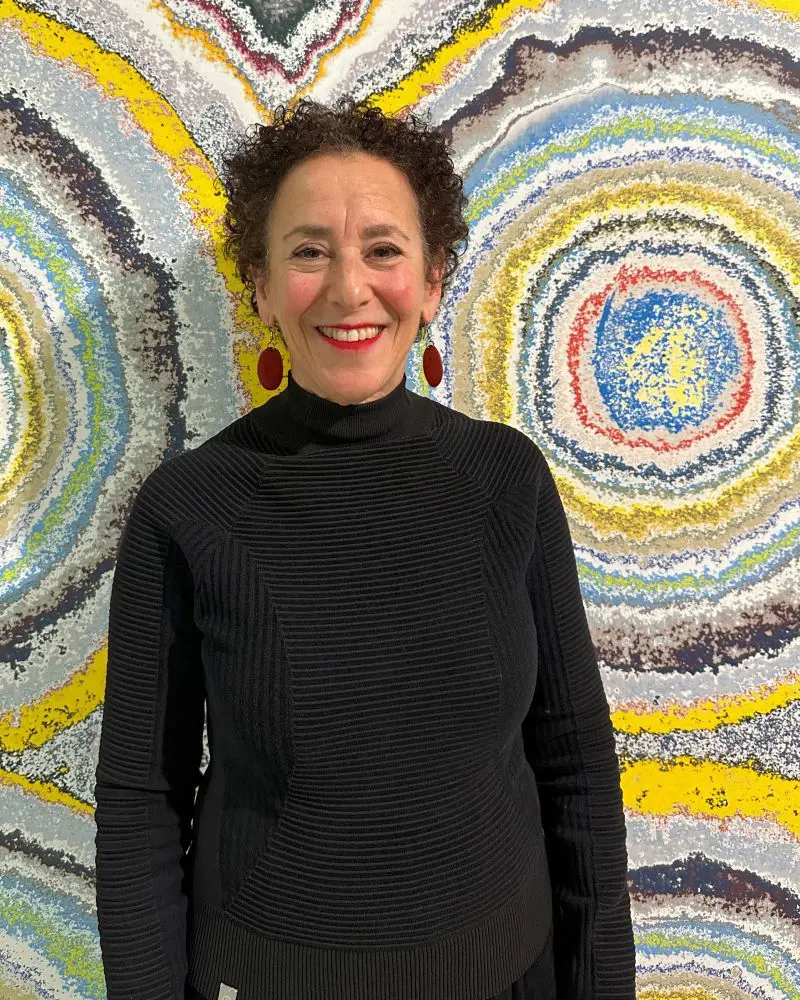
Susan Rome, 2024
Tell us a little bit about your role at the Gallery and the work that you do.
Susan Rome (SR): My role is to design the Gallery’s School Program for students in Grades 1 through 12. I work in collaboration with an extraordinary staff of Gallery Educators. In response to the exhibitions on display, we create interactive tours and hands-on workshops, which include everything from sculpture to oil pastel drawing, to textiles, to stop-motion videos. As part of my work, I train the Gallery’s Docents, volunteer educators who lead the School Tours. This is a rigorous adult art education course, held weekly from September to June, during which we focus on exhibition content, pedagogy and presentation.
I also work to do professional development with teachers throughout the province and with student teachers at UBC and SFU, introducing them to gallery education strategies. In addition, in collaboration with teachers and artists, I create multi-day, immersive programs for teens, called the Think Tank for Art and Ideas. I also develop after-school programs for teens, including Art Exchange, in partnership with Arts Umbrella, and the Teen Art Group, in partnership Emily Carr University of Art + Design. Part of my role is to act as a mentor to teens and university students, providing internship opportunities in the Gallery’s School Programs.
This year, I am serving as the Co-Chair for the Canadian Art Gallery Educators, a national organization which brings together its members to share innovative, activist practice in our field.
How long have you worked at the Gallery? What are some of your early memories of the Gallery when you first started?
SR: October 2024 marks my 36th year working at the Vancouver Art Gallery, but honestly it seems like I’ve only been here for a few.
My earliest memories are working with the late, great Judith Mastai, former Head of Public Programs and a major force in Vancouver art circles. She instilled in me the idea that education is the core mission of an art gallery. Together, we developed a project which responded to skinheads marching through the streets of Vancouver in the late 1980s called, “Facing History and Ourselves,” based on a Holocaust Education program from Boston. I worked with art and social studies senior secondary school teachers to develop a week-long program in which we compared Nazi propaganda with contemporary propaganda.
The Grade 11/12 students attended the Gallery with their art and social studies teachers, a Holocaust survivor and an artist in residence, whose work was on exhibition at the time, along with that of Jeff Wall, Barbara Todd and Felix Gonzales-Torres. The students spent two days creating collaborative artworks in response to the big ideas that were discussed, and their amazing work was exhibited in the Gallery’s Annex Workshop. We did three of these week-long projects each year for seven years. These were probably the most powerful and memorable programs of my career, and I think it had the same impact for the students.
What is the Gallery’s approach to School Programs and art education?
SR: Our aim is to create a very dynamic, innovative and interactive program that engages and inspires students to ask questions and think critically. We want to facilitate conversations about ideas that are generated from the artworks on view. We help students make a connection between what they see in the Gallery and their own lives. By making the work relevant, we begin to see students understand new perspectives and a myriad of possibilities that exist. We do this by using a variety of strategies that respond to all the different kinds of learners in a class. We focus on materials, narratives and process through responding and making.
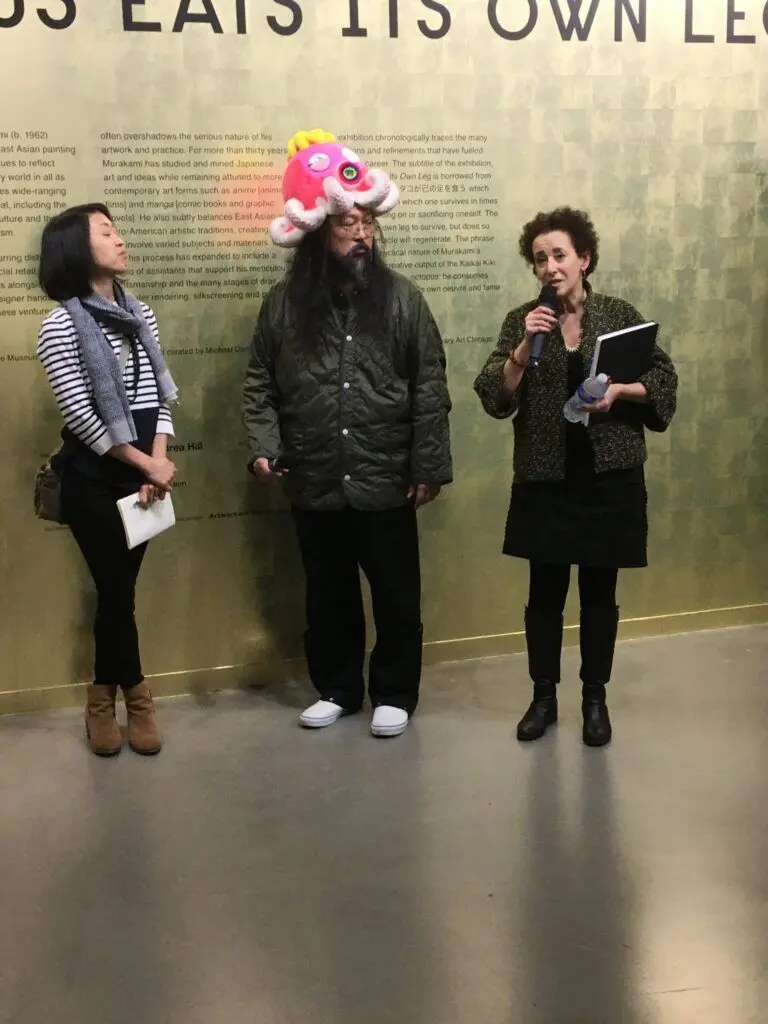
Susan with Takashi Murakami during a tour of the exhibition Takashi Murakami: The Octopus Eats Its Own Leg.
Can you tell us a bit more about the programs you oversee and what your day-to-day work at the Gallery entails?
SR: Each day is different, which is why I still love my job as much today as I did 36 years ago. I work with over 30 volunteers and five staff, each of whom are an integral part of the School Programs team and ensure that the programs run smoothly. We offer 16 tours and eight hands-on workshops every week from September to June.
My days may involve training new docents, researching exhibitions, troubleshooting workshops, sourcing and purchasing art materials, meeting with artists and teachers to develop new projects, writing the tour script, meeting with staff to brainstorm new ideas for workshops, editing the teachers’ study guide, checking in with docents and tour liaisons about tour logistics and, of course, responding to the requisite emails. It’s a varied and wonderful work week.
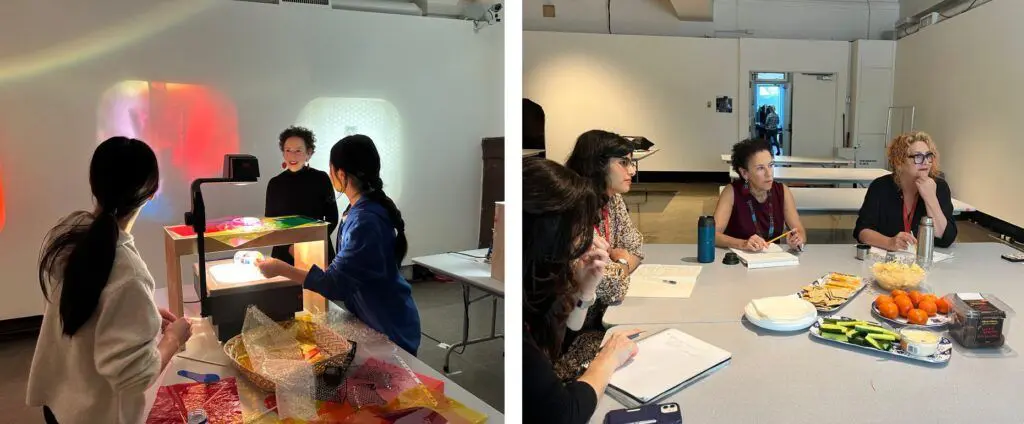
From left to right: Susan Rome working in School Tours, 2024; School and Family Programs staff meeting, 2024
In your over 30 years at the Gallery, what has been one of your favourite exhibitions?
That’s a hard question to answer because there have been so many, but the ones that stand out are those connected to a student project.
One highlight was artist Brian Jungen’s retrospective in 2006, when students from King George Secondary School were inspired by his shelters and reuse of materials. They created shelters, to scale, for homeless youth in the city using old Gallery exhibition banners that had hung on the Georgia facade. We worked with an artist in residence, homeless youth, Mountain Equipment Coop (MEC) designers and Homelessness Advocates from the City of Vancouver as consultants.
Another favourite exhibition was Massive Change in 2004, which focused on new innovations in art, science and technology, with its tag line, “Now that we can do anything, what will we do?”
In response, I organized a multi-day symposium for 100 students from four different schools in the Lower Mainland who were tasked with responding to this question. They came up with the most amazing ideas, ranging from changing the way school cafeteria compost was collected and used, to working with the superintendent of schools to influence the development of the new BC Curriculum.
And, of course, the recent exhibition Kids Take Over in 2022 was a favourite as it involved students in Grades 1, 5 and 12, writing the didactic labels for artworks from the collection on display. I worked with each class four times to introduce them to the permanent collection works and used a variety of techniques to facilitate their responses, including drama, writing and visits from artists whose works were featured in the exhibition.
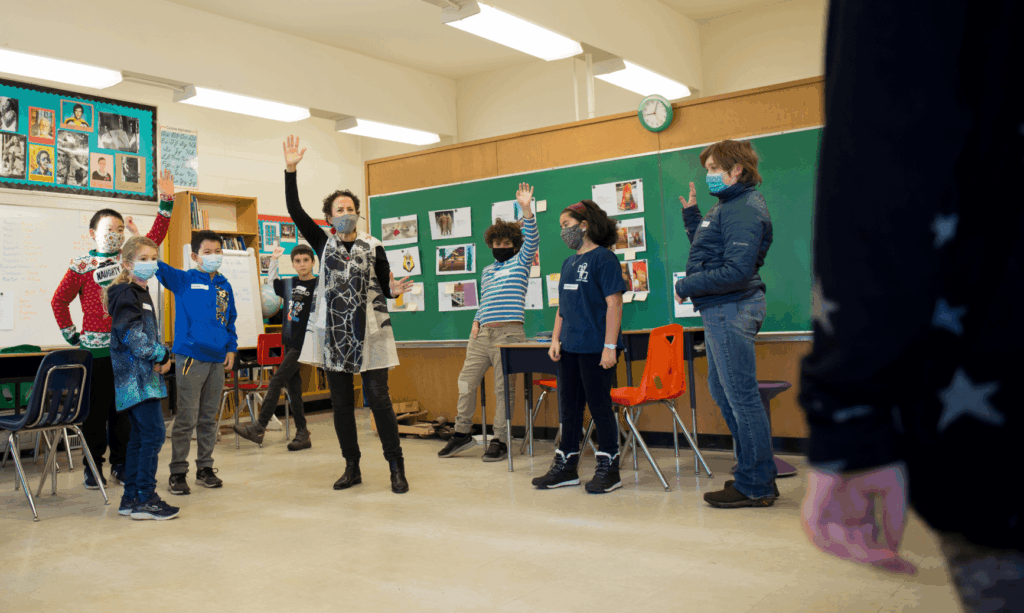
Kids Take Over Workshops, December 2021, Photo: Anita Bonnarens
Thinking back on your time at the Gallery, what has been one of the most memorable experiences here?
It’s always memorable when you see a lightbulb go off for a student. It’s when they connect with the work and get an inspiring new idea from it. It’s very exciting. This experience has happened numerous times with the Teen Program called Art Exchange, presented in partnership with Arts Umbrella. The students, aged 13 to 15, spend 12 hours in studio creating their own personal responses to an exhibition they viewed at the Gallery. Then, they collaboratively curate and display their work in an exhibition of their own at Arts Umbrella. Their work is consistently memorable because it appears so far beyond their years in the way they connect the ideas of the Gallery exhibitions to their lives with the imaginative use of materials.
I’ve worked with hundreds of artists, but some are memorable, particularly those who focus on justice issues. Artist Kerry James Marshall spoke with the School Programs Educators for hours about his iconography and told us something I’ve taken to heart in my work: a museum is a place for questions and ideas.
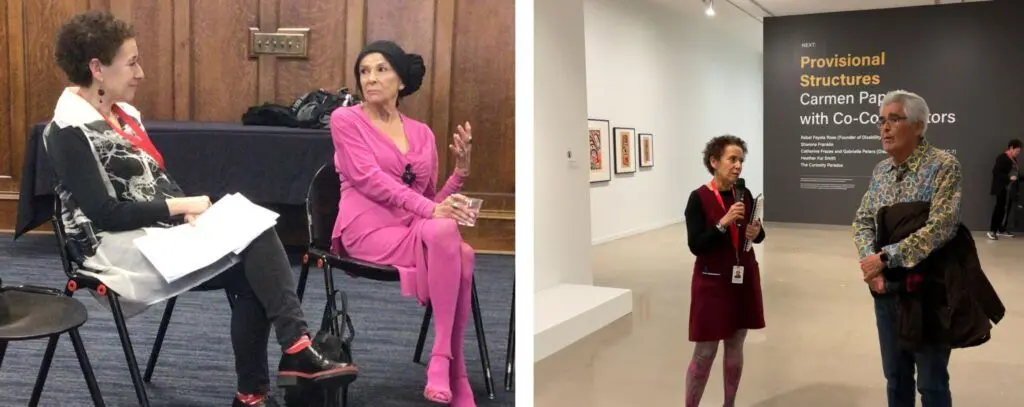
From left to right: Teen Art Group with Alanis Obomsawin, 2023; Docent Tour with Robert Davidson, 2023
Jan Wade was exceptionally generous in working with school groups of all ages and sharing her process, materials and ideas as the first Black woman to have a retrospective at the Gallery.
Robert Davidson shared many powerful stories about his Haida culture with grace and humour, and, as a complement to his exhibition, he created a special template for children and a design video, which he allowed us to use during our School Tours and Workshops.
Takashi Murakami, hailing from Japan, allowed teens to preview his retrospective before any of the media or public had seen it. He spent hours telling the students about his childhood influences and the effect of the leak of the nuclear power plant.
Most recently, I had the distinct honour of spending the day with legendary Indigenous filmmaker and activist Alanis Obamsawin at an elementary school, where she regaled the students with songs from her Abenaki culture and answered countless questions from the students about her work and her life at age 90. In the afternoon, instead of appearing on time for a press conference, she gave her full attention and time to the Teen Art Group, telling them they were more important. They were in awe, as was I.
But by far my most memorable experience at the Gallery has been to be part of a community of practice, collaborating over many years with a group of Gallery Educators who are incredibly creative, smart, thoughtful and generous. Together, we make a bit of alchemy.
As an example, for the School Workshop we developed for the current exhibition Black and White and Everything in Between: A Monohrome Journey, we combined old school overhead projectors and coloured gels with new iPads to capture the students’ creative process in a timelapse format. At the end of the workshop, all of the students’ animated movies are projected to the entire class with music in the background. In less than one hour, the students truly create a monochrome journey.
The passion, the commitment and the creative skills present in all of my colleagues is infectious and the reason I love my job.
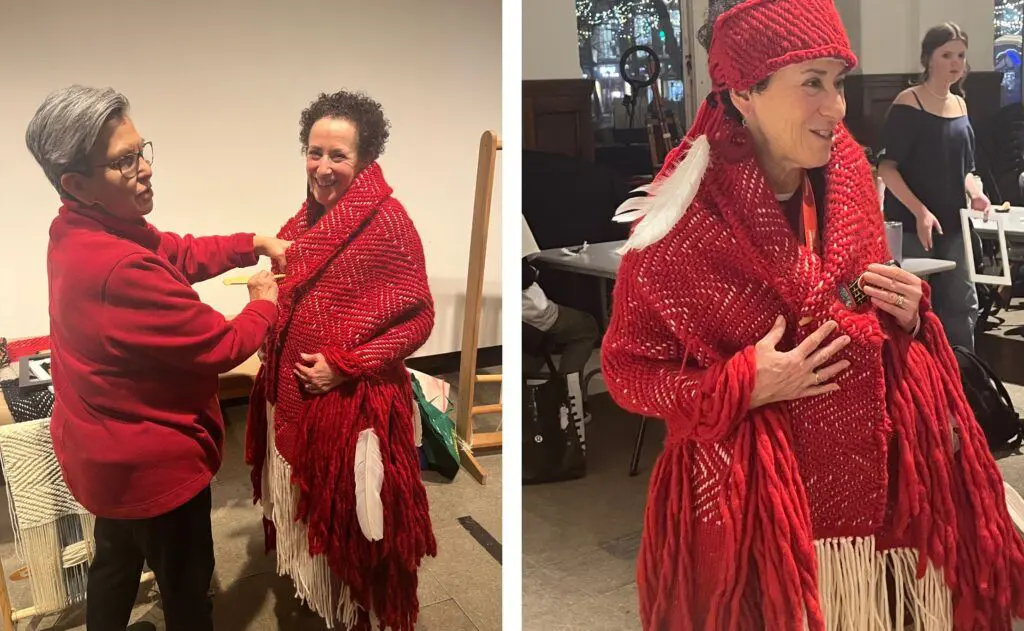
Susan Rome with Salish weaver Xwemilut Lisa Lewis from the Squamish (Sḵwx̱wú7mesh) Nation, 2024
FIND OUT MORE ABOUT THE GALLERY’S SCHOOL PROGRAMS
The Vancouver Art Gallery’s School Programs provide exhibition tours and workshops designed for elementary and secondary school groups. These programs introduce tools to foster visual literacy and to promote critical thinking about the world around us through strategies of close looking and response.
Led by the Gallery’s education staff, School Tours and Workshops are a great way to learn more about the cultural and social contexts of art.
Winter/Spring 2025 School Programs will run from February 18 to June 19, 2025. Registration opens on Saturday, January 18, 2025, at 9 AM.
